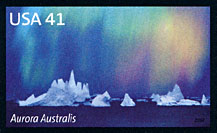
| Holocene climate James S. Aber |
| Sunspot minima | Auroras |
| Radiocarbon | Volcanic activity |
| Human influence | Conclusions |
| Related site | References |

| Holocene climate James S. Aber |
| Sunspot minima | Auroras |
| Radiocarbon | Volcanic activity |
| Human influence | Conclusions |
| Related site | References |
 Sun-spot cycle, 1750 to 2000. Although relatively constant in duration, the cycle shows marked changes in the number of sun spots. Note low intervals during the early 1800s and again during the late 1800s and early 1900s. See recent sunspot cycle. Image from NASA Jet Propulsion Laboratory. | |
| Name | Date| Maunder Minimum | 1645-1715 | Spörer Minimum | 1416-1534 | Wolf Minimum | 1280-1350 | |
|---|
During Medieval time, auroral displays were considered supernatural events, which usually instilled terror in the populations of Europe. The most common forms of auroras are wavy or arching curtains or loops with a fine rayed structure. Auroras are actually formed in the ionosphere, some 120-480 km above the Earth. The color is generated by interaction of energetic electrons with atomic oxygen. Electrons strike and excite atomic oxygen; as the oxygen atom returns to ground state, visible light is emitted in two wavelengths: 0.557 µm (green) and 0.630 µm (red).
Auroras are the visible results of electrical discharges in the magnetosphere that are powered by solar wind. These discharges are visible in the night sky in a pattern that is roughly semicircular around the pole. Auroras are often accompanied by strong geomagnetic disturbances. A close connection between solar activity and geomagnetism was noted early in the twentieth century by Maunder himself. The occurrence of auroras follows a cycle similar to the sunspot cycle, and great auroral displays in mid-latitudes are usually associated with intense flares in the vicinity of sunspots. Auroras are thus an earthly manifestation of solar activity.

| Large cluster of sunspots on the solar surface. Photo courtesy of Mark Brown at Moments by Mark Photography. |
According to Eddy (1977, p. 83), "... in the long view the present-day frequency of sunspots and auroras is probably unusual, and since the 17th century the activity of the sun has risen steadily to a very high level—a level perhaps unequaled in this millennium."
In fact, auroras have become increasingly common during the early 21st century in the mid latitudes. In May 2024, for example, an immense geomagnetic storm on the Sun generated spectacular auroras across the northern hemisphere as far south as Florida and Puerto Rico in the United States. The dark sky of the Flint Hills in Kansas provided an excellent setting for viewing the aurora.

| Awesome aurora seen over the Flint Hills in Kansas on May 10, 2024. Notice the distinct colors, green toward the bottom and reddish purple upward. Photos courtesy of Mark Brown at Moments by Mark Photography. | 
|

Ancient tree rings contain a year-by-year record of past 14C
abundance. During the period AD 1650-1750, 14C content is
anomalously high in tree rings. This is called the DeVries effect,
and it is exactly what would be expected during a long sunspot minimum.
The DeVries effect provides strong confirmation for the existence of the
Maunder Minimum. A complete tree-ring record for bristlecone pine
(Pinus aristata) of eastern California extends back over 8000 years.
During this interval, several fluctuations in 14C content, both
positive and negative, are present, and some of these events are greater in
magnitude than the DeVries effect.
Two periods of glacial expansion are generally recognized in the Alps,
Scandinavia, and western Canada during the late Holocene. These periods
correspond closely with solar minima known from historical and tree-ring
records (based on Eddy 1977; Osborn and Karlstrom 1988).
The late Holocene Neoglaciation was significantly cooler compared with the mid-Holocene climatic optimum (see Holocene climate). Sea-floor sediments and microfossils from north of Iceland demonstrate a close link between sea-surface temperature and solar variations during the past four millennia (Jiang et al. 2015). In fact, climate of the northern Atlantic region varies with solar activity on multidecadal to centennial time scales with a slight lag between solar forcing and climatic response. Both the Little Ice Age and Medieval climatic optimum are quite marked events in this record.
A series of major volcanic eruptions took place in tropical regions during the 13th century (1258, 1268, 1275, 1285). These may have triggered the start of the Little Ice Age (Zorin 2012). Another large tropical eruption in 1450 coincided with the Spörer Minimum. These tropical volcanoes combined with elevated Icelandic eruptions contributed to climatic severity of the Little Ice Age.
Ice cores provide high-resolution records of global volcanic eruptions, as noted by geochemistry and conductivity variations in the ice. Antarctic and Greenland ice cores demonstrate volcanic eruptions during the past few millennia capable of influencing climate on decadal timespans. This evidence has been combined with composite tree-ring series from the northern hemisphere, which reflect summer temperature variations. On this basis, it appears that volcanic eruptions played a major role in cooling events in the northern hemisphere during the past 600 years (Nesje and Dahl 2000; Morton 2012).
Another significant cooling event took place in the mid-sixth century AD as a consequence of volcanic eruptions (Nooren et al. 2017). It began with northern high-latitude eruptions in 536 and culminated with a major eruption at El Chichón in southern Mexico in 540. This led to a reduction in mean summer temperature of 1.5 °C in the northern hemisphere for the period 540-554 compared with the previous three decades. The massive eruption of El Chichón contributed to warfare and the dark age in Mayan history.
More recently, the eruption of Mt. Pinatubo and other volcanoes in the early 1990s led to a pronounced global cooling. Many lesser eruptions have taken place in the early twenty-first century, and the cumulative effect of these is to restrain climate change (Biello 2014). For example, Mount Kelud's 2014 eruption in Indonesia injected sulfur dioxide up to 28 km high into the stratosphere. The sulfur dioxide then turns to sulfuric acid that reflects incoming sunlight. Numerous volcanic eruptions, reduced solar output, and massive air pollution from burning coal (mainly in China) have combined to lessen the impact of global warming from increased greenhouse gases.
Radiocarbon and tree rings
The production of 14C is controlled by the amount of cosmic
radiation reaching the upper atmosphere. The solar magnetic field
partially shields the Earth from cosmic radiation, so any long-term change
in solar activity should result in changing 14C content in the
atmosphere. During prolonged periods of reduced solar activity, more
cosmic radiation would reach the Earth, and more 14C would
accumulate in the atmosphere. Greater solar activity would produce the
opposite effect on 14C abundance.
Solar output during the Maunder Minimum was reduced approximately 0.25%, which is equivalent to a global temperature reduction of about ½ °C; however, the actual temperature decline during the Little Ice Age was ½ to 1½ °C (Nesje and Dahl 2000). This suggests that other factors, namely volcanism, were also at work to create cooler climatic conditions. Volcanic activity
The Earth experiences more-or-less continuous volcanic eruptions along mid-ocean ridges throughout the ocean basins and along subduction zones of the Pacific Ring of Fire. The activity of hot-spot volcanoes seems to be somewhat less regular, however. Iceland is without question the most active hot spot in the world today. It possesses more than 30 volcanoes that have erupted during historical times. Icelandic volcanoes were relatively quiet during the Medieval climatic optimum, when the island had a prosperous environment. Beginning with Hekla in 1104, devastating volcanic eruptions became frequent; some of these were undoubtedly large enough to have influenced global climate.

Eruption from the Tompaluan crater of the dual volcano Lokon-Empung in 2013. Seen from ~5 km (3 miles) away, Tomohon, Indonesia. Adapted from original photo by H. Soosalu; obtained from Wikimedia Commons.

|
Homo sapiens are engaged in massive global changes through immense use of fossil fuels and other mineral resources, vast land conversions, and intense water consumption in order to support and raise the living standard for a rapidly growing human population, which now exceeds 7½ billion people (see population clock). Citizens of developed countries are unlikely to give up their relatively rich and healthy lifestyles, residents of developing countries will seek to achieve the living standards of their richer neighbors, and global population will continue to grow, perhaps reaching a peak around 10 billion people late in this century (Lutz, Sanderson and Scherbov 2001).
According to popular reports, human impact on climate is a consequence of the industrial revolution, particularly with massive burning of fossil fuels (coal and petroleum) that liberates vast quantities of greenhouse gases into the atmosphere. However, the eminent paleoclimatologist, W.F. Ruddiman (2005), has argued that significant human impact on climate began with the advent of agriculture about 8000 years ago. Agriculture has a profound effect on natural vegetation—forest, prairie, and wetland are replaced in favor of various annual crops. The net result is transfer of carbon previously stored in the biomass into the atmosphere. Carbon dioxide is derived mainly from forest clearing; methane is a byproduct of rice and cattle. Increasing levels of atmospheric carbon cannot be absorbed into the oceans at rates as fast as they were created by agricultural expansion. Although this subject is exceedingly complex and much scientific uncertainty remains, there can be no doubt that human impact on climate is ancient.
Ruddiman (2005) believed the natural trend for climatic cooling in the late Holocene may well have been arrested or even reversed by increasing levels of greenhouse gases derived mainly from agriculture. This point of view is supported by recent oxygen-isotope analysis of past interglacials, which suggests the current interglacial may have been prolonged by human disturbance of vegetation (Giaccio et al. 2015).
Burning fossil fuels along with clearing forests, making concrete, and other human activities are the primary causes of increasing atmospheric carbon dioxide. The role of industrial greenhouse gases has yet to manifest its climatic impact fully. The rate of these recent increases far exceeds the rate of climatic change, given the huge thermal masses and lag times involved with ocean and ice-sheet systems. Further climatic warming seems likely, at least until such time as most fossil fuels have been depleted or replaced by other energy sources within this millennium.
Nonetheless, the future role of industrial gas emissions seems likely to spur further warming (Ruddiman 2005). It is currently not possible to understand, let alone predict, changes in volcanic and solar activity. While it appears likely the Earth's climate will continue to warm during the twenty-first century, any attempt to model future global climatic change is an illusory goal.
![]() Related site
Related site
References


© J.S. Aber (2024).